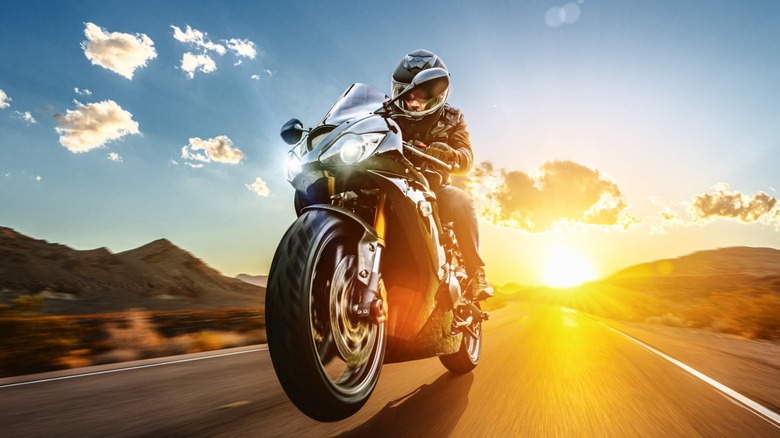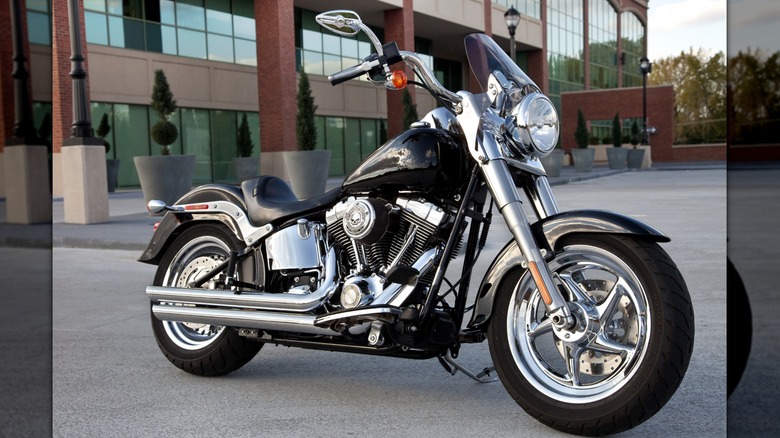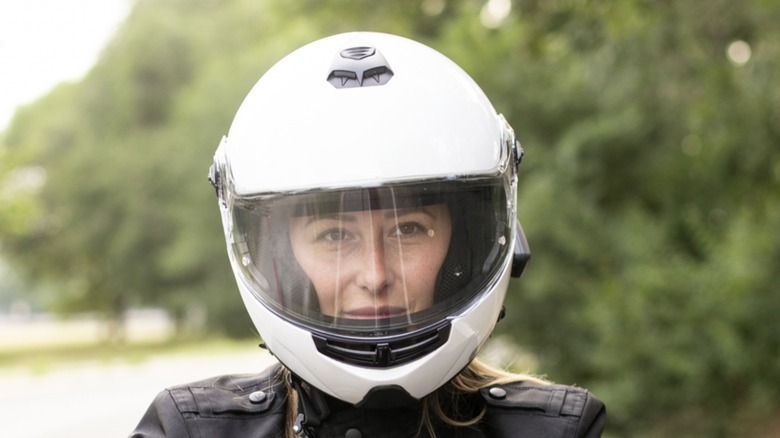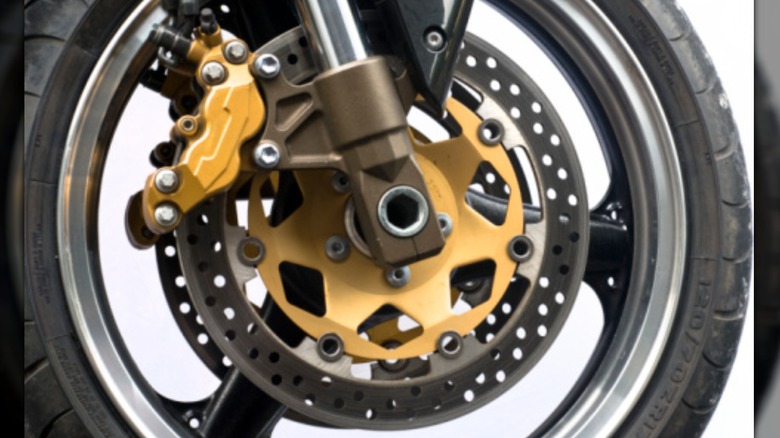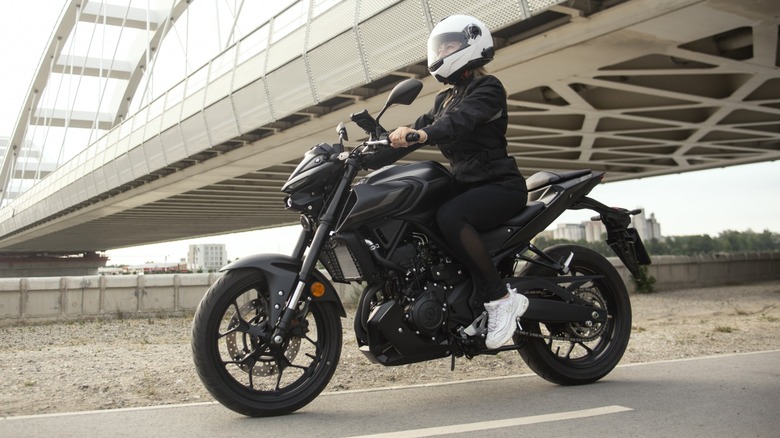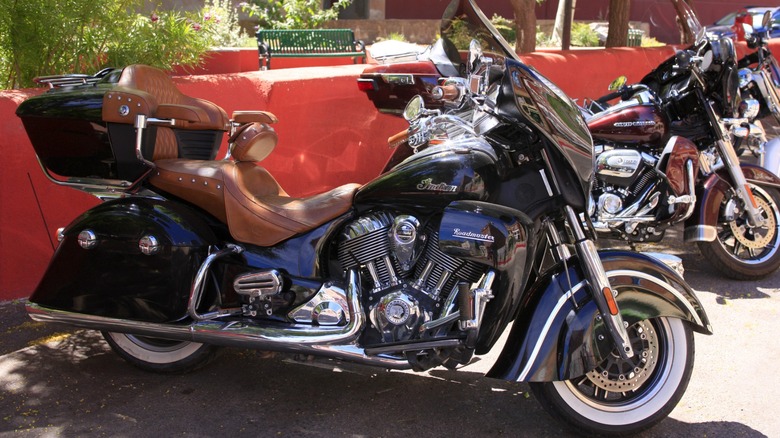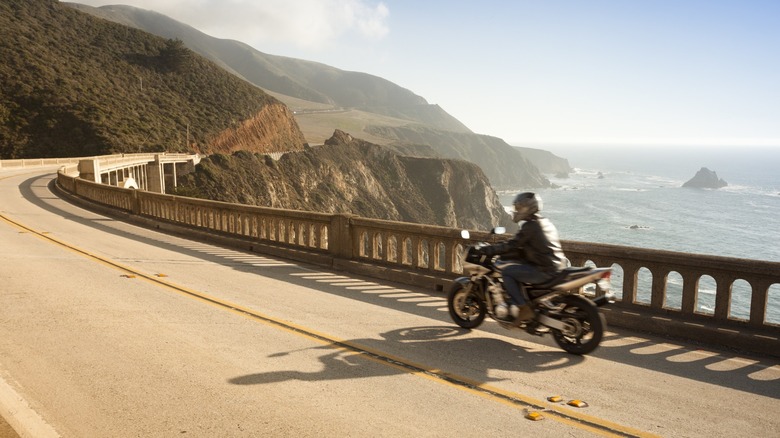8 Myths About Motorcycles You Need To Stop Believing
There's no experience in the modern world quite like riding a motorcycle. The feeling of being in the elements with nothing to block your view creates a connection to the road that does not exist even in a convertible. While a motorcycle provides transportation, the enjoyment of riding can make the ride itself a fulfilling activity, with no destination necessary. That is especially true if given the opportunity to ride through scenic areas such as a national park or a winding mountain road. With the unique experience of riding a motorcycle comes an immediate camaraderie with fellow riders, and, generally speaking, the only thing better than going for a ride is going for a ride with friends.
Motorcycles are impractical for daily use in many places, and therefore, a motorcycle is often a second vehicle. This means there will never be traffic with a large percentage of two-wheelers like you would see in Taiwan or Vietnam, where scooters and motorcycles provide primary transportation for millions. This leads to a vast number of people being unaware of the particulars of riding a bike, and that leads to the creation of myths and misinformation. Even among riders, myths persist based on wives' tales and false assumptions. If you spend enough time on two wheels, particularly if you work in a bike shop, you will hear plenty of unsolicited advice based on scant evidence. To curb this phenomenon, you need to stop believing these myths.
Loud pipes save lives
This is a common refrain from a certain segment of riders almost exclusively riding cruisers, usually American models. The thinking goes that if you have a big Harley with straight pipes installed on it, the excessive exhaust noise will serve as a warning to other drivers, potentially preventing a car from changing lanes and running into your Hawg. On its face, it sounds reasonable, but upon closer inspection, this fails to hold up. This concept was actually studied in Europe using super smart people with fancy degrees and probably a better understanding of science than most of us.
Autoweek reported that they set up tests using decibel meters to see how much sound made it into a closed automobile, although they were constrained to a static test on a quiet street rather than moving down a boulevard. What they discovered is that only the loudest motorcycle could be heard inside the car but only after its front wheel was aligned with the car's front wheel, which would be way past the point of preventing an accident.
The only thing that loud pipes do for cruiser riders is draw attention to themselves and annoy patio diners trying to enjoy a meal at a streetside bistro. Furthermore, they are illegal in a majority of states.
You can ride a scooter with no license
There is some truth to this statement, but it's often repeated by people who do not have all the facts. The legal definitions and regulations of motor vehicles with two wheels and an engine size of less than 50cc vary widely across the United States, and few states have laws that mirror another one.
This generally applies to a moped, which is a motorized bicycle with pedals and an engine, or a scooter, which is a motorized vehicle with an engine that makes up part of the swingarm and features a flat floor for your feet. Scooters come in a range of engine sizes from 49cc up to something like the roughly 650cc engine of the Suzuki Burgman, although most are in the 150cc range. In many states, mopeds and 49cc scooters require no license, insurance, or license plate of any kind. Others only require a driver's license, but no motorcycle endorsement is needed. Some states do not require a license, but insurance and current registration are required. Some states also have specific rules for riders under 18 that do not apply to adult riders.
For the rest of the states, a driver's license with motorcycle endorsement is required, the same as it is for any motorcycle. It's important to check your local regulations. Most importantly, do not rely on what you are told by the seller, because they will say anything to get your money.
It won't happen to me
Sometimes people buy a motorcycle and crash on the way out of the parking lot while others ride for decades unscathed. However, after riding long enough and engaging with other riders, you will eventually talk to someone who doesn't think this will happen to them. This results from an abundance of unearned confidence, a poor understanding of statistics, or optimism bias, the belief that individuals are more likely to experience good outcomes than bad. Regardless of the reason, it's all hubris, and hubris can get you killed, particularly when alcohol is involved. Furthermore, some riders believe their skill and experience mean they won't crash. These are the guys you see in videos online riding wheelies down a highway full of traffic. They are such good riders that they couldn't crash, right?
The truth about motorcycle riding and accidents is that those who are fortunate enough to have not experienced one employ defensive riding skills. Being safe and predictable in your movements and having an acute awareness of your surroundings and the behavior of other drivers keeps you safe. Refraining from doing tricks and street racing prevents tragedy. Riders who accept the level of risk of being on a motorcycle and accept the fact that they cannot control others' behavior in traffic are best equipped to avoid a collision. Some accidents are unavoidable, but far too many accidents are avoidable. The rider who feels invincible on two wheels poses a danger to themselves and others.
Helmets increase injuries
The discussion surrounding helmet use can get heated. Laws differ from state to state. Only 19 states require all riders to wear a helmet and just three have no helmet laws at all. The other 28 states only require helmet use for those under a certain age, usually 17 or 20. Many feel it's their right to make this choice and nobody can tell them otherwise, and they will argue for that freedom with fervor. But often the choice to eschew the helmet is based on false assumptions.
The arguments against mandatory laws usually state reasons why wearing a helmet can be more dangerous than not. The most common argument is that helmets cause spinal injuries. However, the NHTSA states that five studies have shown a higher incidence of neck injuries fo riders without a helmet. Another study from Illinois shows a helmet can decrease the chance of spinal injury. The argument often claims that after a crash, it is when the helmet is removed that an injury can occur, but the same research disproves that notion. The other prominent myth is that helmets block your field of view. Federal law requires helmets to offer a 210-degree range of vision. A normal human range is 220 degrees, but 90% of crashes happen within a 160-degree vision range. Other arguments exist regarding the constitutional rights of motorcycle riders, but the Supreme Court has ruled that helmet laws are no different from any other traffic law.
The front brake myth
There is an old idea that still floats around that it can be dangerous to use the front brake, so riders should just stick to using the rear. This can come from some who have never ridden a bike and think using the front brake will cause the bike to flip over. While it is possible on small bikes that have shorter forks and a narrow rake that could be turned over with the front brake, it requires intentional braking force to do so. Others believe it is better to use the rear brake most of the time, which is likely due to poor advice handed down from older acquaintances.
The truth is that the front brake provides up to 70% of the stopping power on any motorcycle, and they are designed to stop the bike while remaining horizontal. For the most effective braking on a motorcycle, the front brake should always be the primary braking force while the rear helps to modulate braking as an aid to the front brake. Beginning riders tend to overuse the rear brake, which can lead to locking up the rear wheel during panic braking and losing control.
ABS is unnecessary
Motorcycles have been around for well over a century, but ABS is relatively new. It first appeared on cars in the '70 and only became widespread in the '90s. The first motorcycle with ABS was the 1988 BMW K100, but ABS wasn't seen regularly in motorcycle showrooms until the 2000s. As it is with many new technologies, riders were slow to accept a need for the tech. This has also led to a persistent myth that a skilled rider can brake better without ABS.
Some of this comes from the performance of early ABS brakes, which were large and functioned slowly. ABS brakes prevent loss of traction by momentarily releasing brake pressure to allow the wheel to continue to roll when a lockup situation is detected. These moments are measured in milliseconds and the ABS functions by cycling the pressure valve in pulses. In early systems, the pulse could be pronounced but modern systems are nearly imperceptible. Over the years, many riders felt they needed no help in preventing their tires from locking up and could successfully modulate their braking better than the ABS. While highly experienced riders more than likely have developed great skill in braking, particularly during emergency stops, they cannot perform better than a computer-aided ABS. This is borne out by testing. For stopping on any road surfaces that are damp or where gravel or sand are present, ABS can prevent a mishap, and riders should be thankful they have it.
Bigger is better
Hang around American motorcycle riders long enough and you will hear various comments suggesting smaller motorcycles are not suitable, even for beginners. Cruiser guys call the Harley Sportster a beginner bike, despite having an engine of nearly 1,000cc while sportbike riders insist on having at least a 600. Furthermore, other suggestions will have you believe you must graduate to something even larger as soon as possible.
J.D. Power recommends a beginner bike of 250cc, which is reasonable. That size is more than enough to learn how to ride a bike, but the myth is that you even need to graduate to anything else. A 250 will get you around town and keep up with traffic so long as you avoid the interstate, which covers many city-dwelling riders. The truth is that most city riders stay in the city where the extra power is rarely needed and a bigger bike can be less convenient in congested areas. A 500 to 600cc bike is adequate for most situations.
This is not to say that larger bikes aren't enjoyable and have no place. They are all great in their own way. It's just that they aren't required to enjoy riding in a city. The millions of Europeans and Asians who ride daily on motorcycles and scooters of less than 250cc prove it. Everyone should buy the model they want, but shouldn't give in to societal pressure to get more than they need.
Motorcycles are dangerous
More than anything else when you get a motorcycle, you will hear that they are dangerous. You probably won't hear that from anyone who owns one, though. The truth of this is that motorcycles are just a machine and it's riders that make them dangerous. That's not to say there is no inherent risk to riding a bike. There is, and anyone who rides assumes a certain level of risk in riding in traffic without the substantial protection built into modern automobiles. But for most, the risk is worth the reward.
The thing about risk in any endeavor is how to mitigate it. Much like a military commander makes plans to reduce risk to his soldiers, a rider on a motorcycle must do the same for themself. A significant portion of accidents are caused by the rider. 30% of accidents involve only one vehicle and 25% of motorcycle deaths result from a collision with a fixed object. In single-vehicle crashes, two-thirds are caused by rider error, and 42% of fatal single-vehicle accidents involve alcohol impairment. In 2019, speeding contributed to 33% of fatal accidents and 92% of riders involved in a crash were self-taught or learned from a family member.
The bottom line is that motorcycles are not inherently dangerous, but they are risky. It's up to the rider to prevent them from becoming dangerous. With full attention to the road, proper safety equipment, a helmet, and professional rider training, they can be enjoyable for a lifetime.
